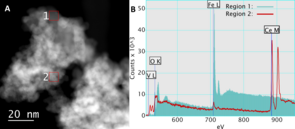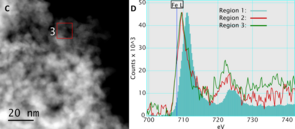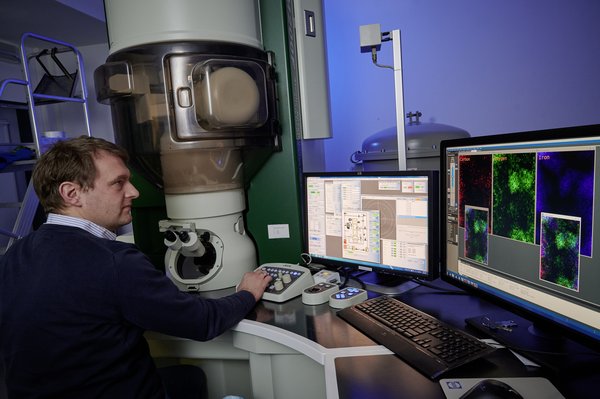Elektron Microscopy
Many heterogeneous catalysts consist of particles with sizes in the nm regime. The morphology of these particles is one of the key factors that determine catalytic activity. Therefore, we use Transmission Electron Microscopy (TEM) to elucidate the characteristics of these catalysts on the smallest scales. Besides imaging the particle structure, we analyze changes in elemental composition or even electronic configuration by spectroscopic methods.
For this objective we operate a transmission electron microscope with a corrector in the condenser (illumination) system. With this corrector we achieve atomic resolution (0.082 nm) in the scanning transmission electron microscopy (STEM) mode with the additional advantage of having access to Z-contrast imaging with the high angle annular dark field (HAADF) detector of heavier elements and an annular bright field (ABF) detector for images of lighter elements like carbon (Fig. 1).
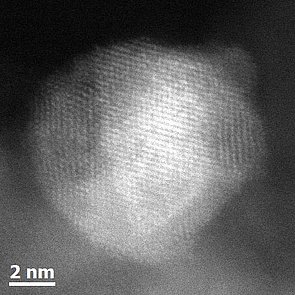
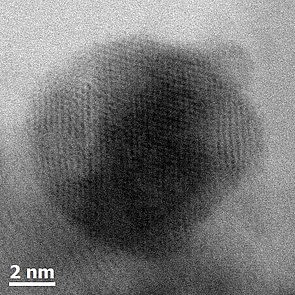
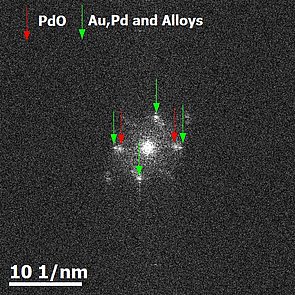
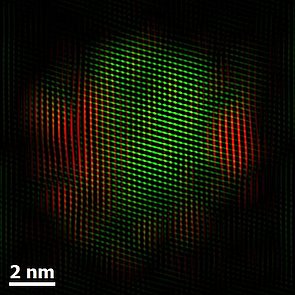
Figure 1: Particle of a Gold-Palladium alloy on Titania: A) HAADF image, B) ABF image, C) Fourier Transform of A) with reflexes of the Au-Pd alloy marked in green and PdO marked in red, D) overlay of inverse Fourier-transforms of PdO (red) and Au-Pd alloy (green) signals.
Using the STEM-mode we can also access spectroscopic data with high spatial resolution providing valuable information on elemental composition and even electronic structure by energy dispersive x-ray spectroscopy (EDXS) and an electron energy loss spectroscopy (EELS) (Fig. 2).
Figure 2: Annular dark field (ADF) images of a Vanadium Cerium Iron catalyst with different Fe loadings for low-temperature NH3-SCR showing the areas from which EEL-spectra have been extracted from the spectroscopic imaging dataset, B) overview EEL-spectra of regions 1 and 2 of A) showing the difference in elemental composition, D) fine structure details of the Fe-signal showing differences due to changes in the electronic structure between region 1 (no V, Ce) and regions 2 and 3 (containing V and Ce). [1]
Equipment:
Transmission Electron Microscope
- JEM-ARM200F (JEOL)
- Schottky emitter (thermals field emission) w/ 0,8 eV energy resolution
- 80 kV, 120 kV and 200 kV accleration voltages
- CESCOR aberration corrector
- HAADF, ADF and ABF detectors
- Dry SGD60 SDD-EDXS-detector (JEOL) with a resolution of 129 eV.
- Enfinium ER EEL spectrometer (Gatan)
In cooperation with the department Life, Light & Matter of the University of Rostock we can also access an aberration corrected STEM with a cold field emitter for higher energy resolution and corresponding analytical capabilities. This microscope is also equipped with special holders from Protochips Inc. for in-situ measurements comprising heating experiments in vacuum, heating in gaseous environments, heating, or biasing in static or flowing liquid media: ELMI-MV - Universität Rostock
------------------
[1] S. Keller, G. Agostini, H. Antoni, C. Kreyenschulte, H. Atia, J. Rabeah, U. Bentrup, A. Brückner, ChemCatChem 10.1002/cctc.201902167

